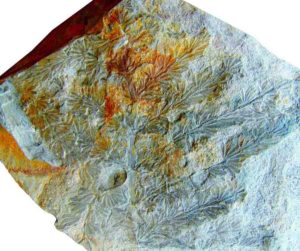
Evolutionary history of ecological interactions between terrestrial arthropods and vascular plants
The interactions between the terrestrial arthropods and vascular plants comprise one of more complex and intriguing terrestrial ecosystems that have persisted from Early Devonian times until today. These interactions are diverse, with multiple species of arthropods, mainly insects, and host-plants interacting over a range of trophic levels through predation (i.e. herbivory), parasitism, and pollination. The features, intensity and diversity of these interactions are mainly influenced by climatic and environmental conditions. Galling represents the most biologically complex of all major arthropod–plant interactions, consisting of parasitic relationships, which are characterized by the endophytic insect-induced plant tissue damage that can occur on all major plant organs. The insect-induced galling damage consists of atypically enlarged plant structures, three-dimensional, conspicuous, generally of bilateral or radial symmetry and externally hardened, that offers to the encapsulated insect larvae a microclimate, nutrition, and protection from natural enemies. The insect galls affect usually the plants only locally, but in some instances can cause systemic effects.
The insect galls have a long evolutionary history and earliest fossil records are known from the Pennsylvanian strata. These earliest insect galls occurred on stems of arborescent ferns and calamitalean sphenopsids. Although insect galls have been well-documented in a wide range of host-plant species, about 80% of extant galls occur on leaves. The Pennsylvanian-age galls are very poorly known because they are rarely found and only occasionally reported in the fossil record.
Host ancient “horsetail” shows insect gall preserved in situ
The horsetails are plants with a very old historical lineage, with fossil record from the Late Devonian to the present day, existing in abundance in Portugal today. The new species hosted Annularia paisii shows an insect gall induced by parasitoid insects (popularly known as galling insects), which is an ichnospecies until now unknown for science that received a name of Paleogallus carpannularites. This shows the existence of complex insect-plant relationships 303 million years ago and reiterates the importance of the fossil record of the Portuguese Carboniferous. The patterns of herbivory of insects and other arthropods on horsetails are little known. In our paper, recently published in the International Journal of Plant Sciences, we addresses this subject, in which they document 315 million years of sphenophyte herbivory relationships by arthropod.
Ecological adaptation of Annularia paisii
The arrangement of the leaves of Annularia paisii appears anomalous for a species of Annularia. Its leaves are arranged in cup-shaped whorls, a typical characteristic of other calamitalean sphenopsid like fossil genus Asterophyllites. Several explanations can account for this condition. The leaves of Annularia paisii perhaps were retracted into a cup shape during their burial. Alternatively, the cup shape could have been an induced feature resulting from their sensitivity to sunlight or an external tactile stimulus similar to the modern sensitive plant, Mimosa pudica. Another possibility is a physiological reaction from an herbivorous insect, such as a gall antagonism. Annularia paisii is named in honor of the Portuguese paleobotanist João Pais (1949–2016) from Nova University in Lisbon (Portugal).
Reference:
Pedro Correia, Arden R. Bashforth, Zbynĕk Šimůnek, Christopher J. Cleal, Artur A. Sá, and Conrad C. Labandeira, “The History of Herbivory on Sphenophytes: A New Calamitalean with an Insect Gall from the Upper Pennsylvanian of Portugal and a Review of Arthropod Herbivory on an Ancient Lineage,” International Journal of Plant Sciences. DOI: 10.1086/707105
Note: The above post is reprinted from materials provided by Institute of Earth Sciences of University of the Porto, Portugal.










